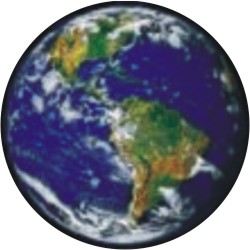Science Feature
Clouds May Hold Key to Why
Early Earth Didn't Freeze Over
Andrea Thompson
 A paradox about the climate of the early Earth that has been plaguing scientists for nearly 50 years may have a new solution. A paradox about the climate of the early Earth that has been plaguing scientists for nearly 50 years may have a new solution.
The so-called 'young' sun paradox first proposed by Carl Sagan and his colleague George Mullen in 1972 refers to the fact that the Earth had liquid oceans for the first half of its more than 4-billion-year existence despite the fact that the sun was likely only 70 percent as bright in its youth as it is now.
A lower solar luminosity should have left Earth's oceans frozen over, but there is ample evidence in the Earth's geological record that there was liquid water and life on the planet at the time.
Over the past few decades, scientists have proposed several possible mechanisms that may have kept the Earth toasty enough to keep water from freezing during our planet's early history a period of time called the Archaean. But just when scientists think they have the paradox solved, other researchers come up with alternate explanations or reasons why a previous proposal doesn't work.
"It keeps resurfacing," said atmospheric scientist Jim Kasting of Penn State University, who put forward his own explanation for the young sun paradox in 1980s and '90s. That explanation involved a greenhouse gas effect that would have kept the planet warm similar to the human-driven effect that is warming the Earth today. The early greenhouse, first proposed by other scientists in the 1970s, would have been on a much larger scale than current climate warming, with theoretical calculations suggesting that about 30 percent of the Earth's atmosphere at the time consisted of carbon dioxide. For comparison, today, Earth's atmosphere is about 0.038 percent carbon dioxide.
A powerful greenhouse effect on the early Earth is "the obvious solution" to the paradox, said Minik Rosing of the University of Copenhagen in Denmark. Rosing and his colleagues have offered up a new explanation for the seeming paradox that is detailed in the April 1 issue of the journal Nature.
Carbon dioxide constraints
To see what carbon dioxide (CO2) concentrations might have actually been in the Archaean, Rosing and his team analyzed samples of 3.8-billion-year-old mountain rock from the world's oldest sedimentary rock, called Isua, in western Greenland.
The samples contain features called banded iron formations (BIFs) that formed in abundance when the Earth was young, but not since. These BIFs contain certain iron-rich minerals that give clues as to the atmospheric environment in which they formed.
"The analyses of the CO2 content in the atmosphere, which can be deduced from the age-old rock, show that the atmosphere at the time contained a maximum of one part per thousand of this greenhouse gas. This was three to four times more than the atmosphere's CO2 content today. However, not anywhere in the range of the 30 percent share in early Earth history which has hitherto been the theoretical calculation," Rosing said. So Rosing and his colleagues looked at another avenue that could explain the paradox.
All about albedo
One of the factors that partly determines the temperature of the Earth is the amount of incoming sunlight the Earth's surface and atmosphere reflect back to space, called the planet's albedo. Different types of surfaces reflect or absorb different amounts of light for example, ice is highly reflective, while the open ocean is highly absorptive.
Rosing and his team looked at two possible influences on the early Earth's albedo: the amount of land on the planet's surface and the amount of cloud cover in the atmosphere.
Geologists haven't yet determined when the Earth's continents first formed, but radioactive tracers in the hot rock of the Earth's mantle can help determine the rate at which the crust of the planet formed, hinting at how much land was exposed above the oceans.
SPACE.com
| 